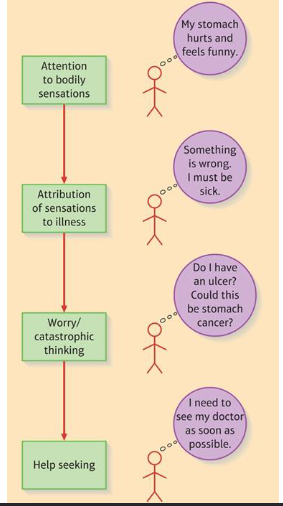Somatic Symptoms and Dissociative Disorders (start of final exam information)
1/17
There's no tags or description
Looks like no tags are added yet.
Name | Mastery | Learn | Test | Matching | Spaced |
|---|
No study sessions yet.
18 Terms
Somatic symptom and related disorders
Somatic symptom disorder
Illness anxiety disorder
Conversion disorder
Factitious disorder
Change substantially from DSM - IV to DSM - 5
Soma = body
Somatic Symptom Disorder
Chronically bodily sx that are distressing + dysfunctional thoughts, feelings, and/or behaviors
Includes DSM - IV’s hypochondriasis, somatization disorder, and pain disorder
No assumptions about cause
DSM tries to move away from the idea of misdiagnosing and no assumption of the cause.
Somatic Symptom Disorder: Causes
Psychodynamic
Develops as a defense mechanism of unresolved conflicts
Somatic Symptom Disorder: Causes
Cognitive-Behavioral
- Disorder of perception/cognition or attentional bias?
- Past experience with illness
- observed in self, others or media
“ if you don’t go to the doctor as soon as you notice something unusual, then it will be too late”

Risk Factors of Somatic Symptom Disorder
Negative affect
Absorption
some people might be able to absorb In an experience and be so focused and no one is able to distract them
Alexithymia
- Emotional blindness; struggle to identify what is going on internally
Reinforcements in Somatic Symptom disorders
Special attention and comforts but, NOT malingering
getting more attention and support but not intentional; feel better when they go to the doctors and and reinforces that going to the doctors is good and will go back again if they are in pain again. NOT faking the symptoms.
Somatic Symptom Disorder: Treatment
CBT
Assess beliefs in illness and moidft misinterpretation of boduly sensations
Induce symptoms, learn selective perception can play a role
Response prevention (checking body, doctor visits)
Med management
-Regular visits with one doctor, physical exams, and unnecessary exams
- Need to be with CBT
Illness Anxiety Disorder
High anxiety about having or developing in serious illness
New to DSM - 5
Conversion Disorder
Presence of neurological sx in absence if neurological diagnosis'
4 categories
Sensory, motor, seizure, mix
“La belle indifference”
- some people would feel indifferent when they could not feel their leg or become blind
Conversion Disorder: Causes
Results if stress or internal conflict
- Psychodynamic
repressed sexual energy
primary and secondary gain
- Learning theory
Physical sx provide negative and positive reinforcement
- Sociocultural
More socially acceptable to have phsysical disorder than anxiety
Conversion Disorder: Treatment
Remove reinforcement of sx and provide reinforcement of wanted behaviors
Hypnosis?
More research is needed
Factitious Disorder
Deliberately and consciously feign disability of illness, intentionally prodices sx to maintain benefits if sick role
No theoretical model of why it develops
Dangerous variant
Factitious disorder imposed on another
Dissociative Disorders
Depersonalization/Derealization Disorder
Dissociative amnesia
Dissociative identity Disorder
Depersonalization/Derealization Disorder
Derealization
sense of reality if outside world is temporarily lost
Depersonalization
sense of one’s own self and one’s own reality is temporarily lost
Different than psychosis
Little research
Dissociative Amnesia
Limited retrograde amnesia, often follows stress
Subtype: dissociate fugue
might forget entirely who they are and live a brand new life move somewhere else and go by different identity
Little research
Dissociative Identity Disorder
Disruption of identity characterized by 2 or more distinct identities as well as recurrent episodes of amnesia as reported by self or others
Name changed from earlier DSMs
Dissociative identity disorder: Controversy
Is DID real or fake?
If DID is not faked, how does it develop: traumatic theory or sociocognitive theory?
Are recovered memories if abuse in DID real or fake?
If abused has occurred, does It play a causal role?
Dissociative Disorders: Treatment
No clearly effective treatments
No systematic, controlled research exists
YET, some psychodynamic approach to recall and process trauma?